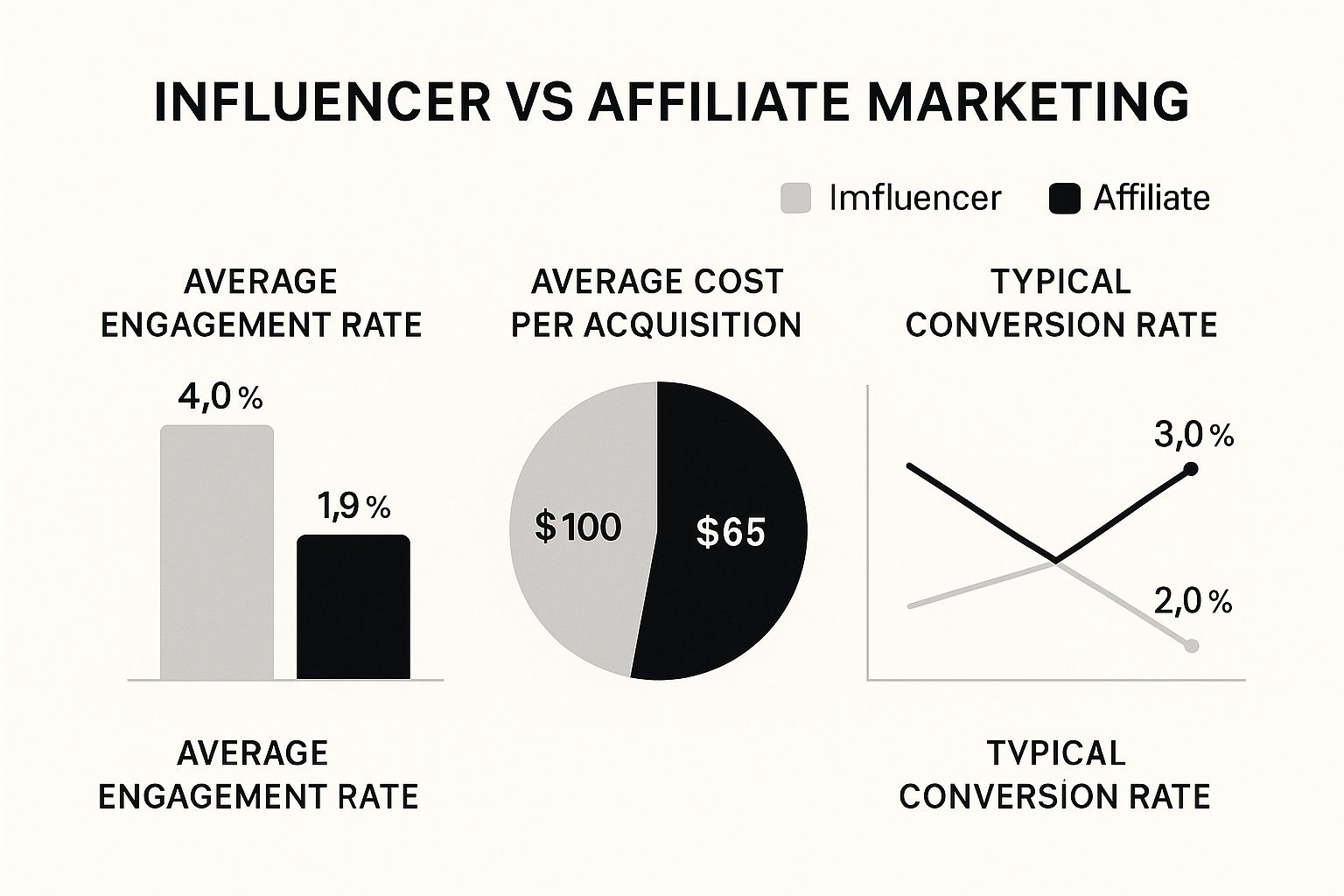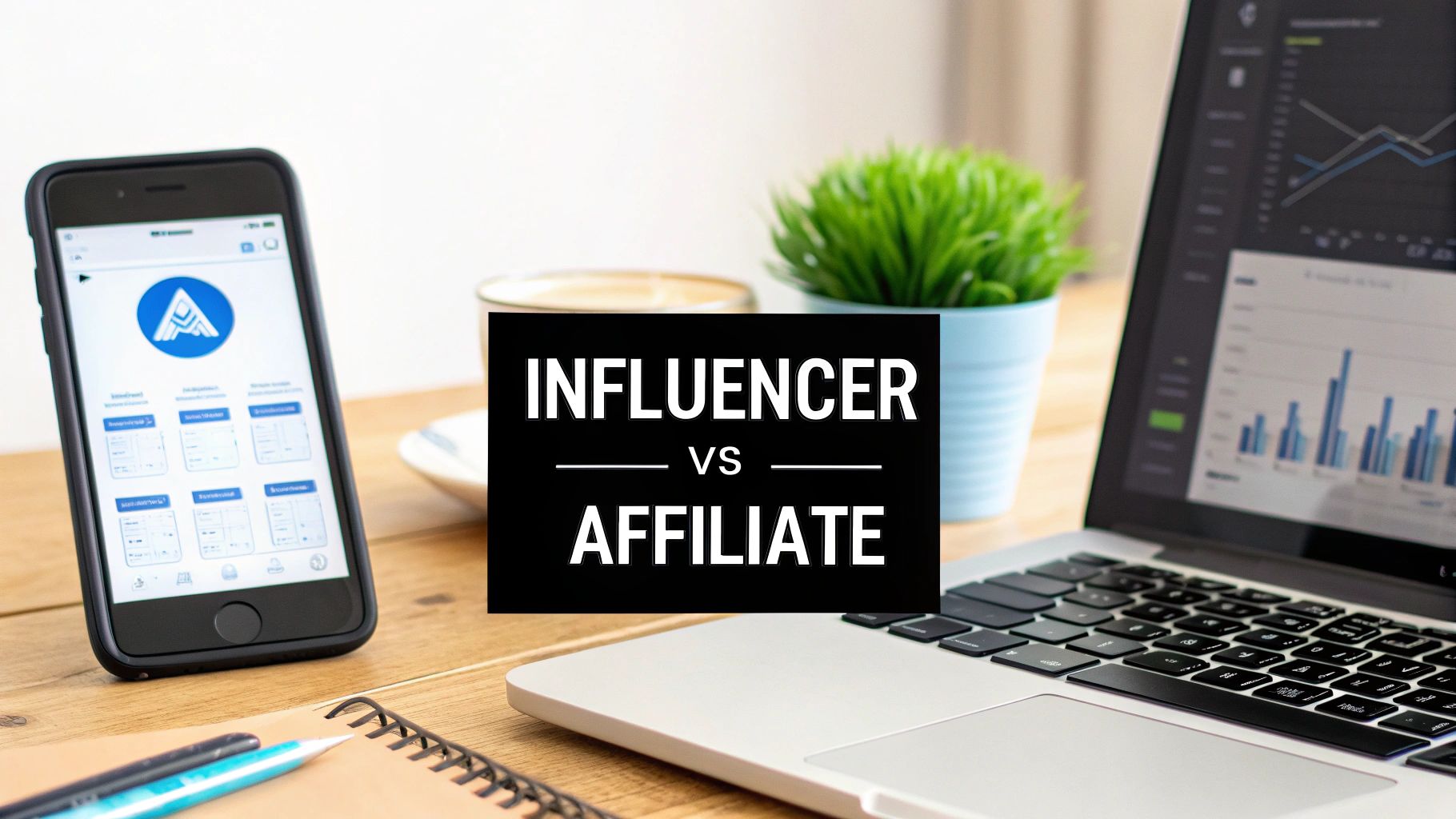When people talk about influencer marketing vs affiliate marketing, they often get them mixed up, but the core difference is actually pretty straightforward. Think of it this way: Influencer marketing is all about building brand awareness and credibility, and you usually pay creators upfront for access to their audience. On the other hand, affiliate marketing is a pure performance game—you only pay for sales, making it a low-risk way to drive revenue.
Understanding the Core Differences
At their heart, both strategies use other people's voices to talk about your product. But the way they work and what they aim to achieve are fundamentally different. Nailing down these mechanics is the first step to figuring out which one—or which mix of the two—is right for your SaaS brand.
Influencer marketing is built on relationships. You collaborate with creators—anyone from a nano-influencer with under 10,000 followers to a mega-influencer with millions—to create content that feels genuine. This builds trust and gets your brand in front of a whole new set of eyes. Payment is typically a flat fee, a free product, or some combination, which compensates the creator for their effort and influence. The main goal isn't always an immediate sale; it’s more about creating buzz, getting valuable user-generated content, and building social proof.
Affiliate marketing, in contrast, is all about the transaction. It's a direct-response channel where you give partners (affiliates) a unique tracking link, and they earn a commission for every sale or lead they send your way. These partners can be anyone from bloggers and coupon sites to even influencers themselves. The whole system is built on measurable results, which makes it incredibly efficient and low-risk from a financial standpoint. If you want to dive deeper into the nuts and bolts, learning about effective affiliate management is a great place to start.
Key Takeaway: With influencer marketing, you're paying for access and authenticity to tell your brand's story. With affiliate marketing, you're paying for conversions to drive direct revenue.
Influencer vs Affiliate Marketing At a Glance
To make things even clearer, let's break down the essential differences side-by-side. This table gives you a quick snapshot of how each approach stacks up.
| Attribute | Influencer Marketing | Affiliate Marketing |
|---|---|---|
| Primary Goal | Brand Awareness & Credibility | Sales & Lead Generation |
| Payment Model | Upfront Fees, Free Product | Performance-Based Commission |
| Focus | Content & Authenticity | Conversions & Traffic |
| Risk Level | Higher Upfront Financial Risk | Lower Financial Risk |
| Typical Partners | Social Media Creators | Bloggers, Review Sites, Publishers |
As you can see, one isn't inherently better than the other. They simply serve different purposes. Influencers are your storytellers, while affiliates are your performance-driven sales force.
Comparing Strategic Goals and Funnel Position

The real difference in the influencer marketing vs affiliate marketing debate boils down to intent. It’s about where each strategy fits into your sales funnel. One builds the story around your brand, while the other is laser-focused on closing the deal. They aren't interchangeable tools; they solve different—though often related—business problems.
Influencer marketing is your top-of-funnel workhorse. Its main job is to get your name out there, build credibility, and generate authentic content that resonates with potential customers. Think of it as planting seeds. When a SaaS company gets a respected industry voice to demo a new feature, the goal isn't just a flood of immediate sign-ups. It's about educating the market and building a foundation of trust.
This approach introduces your brand to a new audience through someone they already follow and respect, which feels a lot less like a traditional ad and more like a solid recommendation from a friend. The entire focus is on storytelling and shaping a positive brand image long before someone is even thinking about pulling out their credit card.
Where Each Strategy Shines in the Funnel
Understanding where these tactics live in the funnel changes everything—from who you partner with to how you structure your campaigns. Influencers are great for building an engaged community, but affiliates are wired to capitalize on existing buyer intent.
Influencer Marketing (Top of Funnel): This is your go-to for launching a new product. Imagine a tech influencer creating a "first look" video for your new software. They're not just showing features; they're explaining its value to a broad but highly relevant audience, sparking that initial curiosity.
Affiliate Marketing (Bottom of Funnel): This is purely transactional. An affiliate, like a high-traffic review site or a niche blogger, targets people who are actively looking for a solution like yours. They provide a direct path to purchase, often with a compelling discount code to seal the deal.
The way I see it, influencer marketing creates the "why"—it builds the emotional connection and tells your brand's story. Affiliate marketing provides the "how"—the straightforward, trackable link to make a purchase.
Conversion vs. Credibility: The Core Divide
On the flip side, affiliate marketing is a bottom-of-funnel machine. It's built for one thing: driving conversions and generating direct revenue. It’s less about the narrative and all about the sale. Affiliates are motivated by commissions, so their efforts are concentrated on actions that lead to clear outcomes like clicks, trial sign-ups, and paid subscriptions. Their success is measured by how well they can nudge an already interested audience over the finish line.
The explosive growth of the creator economy really drives home the power of personal connection in marketing. The influencer marketing space is expected to reach a staggering $22.2 billion by 2025, and for good reason. On average, brands are seeing a $4.12 return for every dollar they put in. This shows just how good influencers are at turning genuine engagement into real action. You can dig into more influencer marketing statistics to see the full ROI picture.
Ultimately, the choice comes down to your immediate goal. Are you trying to build a brand that people recognize and trust for the long haul, or do you need to hit a specific sales number this quarter? Your answer will tell you where to start.
Breaking Down the Cost and Payment Models

When you look at influencer vs. affiliate marketing, how you pay for them is one of the biggest differences. Influencer marketing almost always involves paying upfront for potential, not guaranteed results. You're compensating creators for their time, their unique voice, and their connection with an audience.
With influencer campaigns, the payment models are all over the map. You might agree on a flat fee per post, send free products in exchange for a review, or mix the two. The price tag is usually tied to things like follower count, engagement rates, and how much content you’re asking for. A single video from a macro-influencer can easily run into thousands of dollars, making it a serious investment without a direct, immediate return you can count on.
The Affiliate Marketing Financial Model
Affiliate marketing, on the other hand, is built almost entirely on performance. It’s a low-risk model because you only pay when something specific and measurable happens—usually a sale. The most common structure is cost-per-sale (CPS), where affiliates get a cut of the revenue from every customer they send your way.
This pay-for-performance model gives you incredible control over your budget. You don't have major upfront costs, which is a huge plus for SaaS companies that need every marketing dollar to generate a clear return.
The core financial difference is simple: with influencer marketing, you pay for potential reach and creative effort. With affiliate marketing, you pay for verified results. This distinction is critical for businesses deciding where to allocate their budget based on their appetite for risk.
Comparing Payment Structures
These two strategies represent completely different philosophies on budgeting and financial risk. Getting a handle on these nuances will help you figure out which one fits your company’s current growth stage and cash flow.
Here’s a practical look at what to expect from each:
- Influencer Campaigns: This road involves negotiating contracts, defining content deliverables, and paying fees before you see the full impact. It requires you to get a budget approved for an expense with a less predictable, direct ROI.
- Affiliate Programs: These are built around scalable, commission-based payouts. Your costs only go up as your revenue does, making it a self-funding marketing channel that’s incredibly easy to manage financially right from the start.
Ultimately, your choice really boils down to your immediate goals. If you have the capital to invest in building your brand and you value authentic, creative content, the upfront cost of influencer marketing can be a fantastic investment. But if your main focus is scalable, risk-free customer acquisition, the performance-based model of affiliate marketing is the clear financial winner.
Measuring Success and Calculating ROI
When you get down to brass tacks, how you measure success in influencer and affiliate marketing is worlds apart. This is probably the biggest divide between the two. You’re tracking completely different things, so you can’t use the same ruler to measure both.
With influencer marketing, success often feels a bit... softer. We’re talking about top-of-the-funnel metrics like reach, impressions, and engagement rates (all those likes, comments, and shares). The main goal here is to get your brand name out there and build good vibes, which makes tying a specific sale back to a specific post notoriously tricky. It's an investment in brand perception, not just a direct transaction.
On the other hand, affiliate marketing is all about crystal-clear tracking and attribution. Success is measured with hard numbers that directly impact your bottom line: clicks, conversion rates, and cost per acquisition (CPA). Every penny you spend is directly linked to a result you can see, making your return on investment a straightforward calculation.
Core Metrics At A Glance
The image below gives you a solid visual of these performance differences, laying out key data points like engagement and conversion rates side-by-side.

As you can see, influencers tend to light up the engagement metrics, but affiliates often bring home the bacon with more cost-effective conversions. It really drives home how they play different, but complementary, roles in your funnel.
The table below breaks down the key performance indicators for each strategy, showing exactly what you should be tracking to gauge success.
Key Performance Indicators Influencer vs Affiliate Marketing
| Metric Category | Influencer Marketing KPIs | Affiliate Marketing KPIs |
|---|---|---|
| Audience Reach | Impressions, Reach, Follower Growth | Clicks, Click-Through Rate (CTR) |
| Engagement | Likes, Comments, Shares, Saves, Engagement Rate | Conversion Rate, New vs. Returning Customers |
| Conversions | Coupon Code Redemptions, Link Clicks, Branded Search Volume | Number of Sales/Leads, Average Order Value (AOV) |
| Cost & ROI | Cost Per Engagement (CPE), Earned Media Value (EMV) | Cost Per Acquisition (CPA), Return on Ad Spend (ROAS) |
| Brand Impact | Brand Mentions, Sentiment Analysis, Website Traffic Lift | Affiliate Contribution, Top-Performing Affiliates |
This side-by-side view really clarifies where your focus should be depending on the campaign you’re running.
Interpreting Your Return on Investment
For a SaaS company, understanding this ROI difference is absolutely critical. After an influencer campaign, you might look for a jump in brand searches or a surge in website traffic to gauge success. The return here is long-term brand equity.
With affiliate marketing, the ROI is simple math: revenue from affiliate sales minus commission payouts. It’s an incredibly efficient growth channel for that reason. Our deep dive into SaaS affiliate marketing gets into the nitty-gritty of these financial benefits.
Affiliate marketing is a true powerhouse for customer acquisition. It's responsible for driving roughly 16% of all ecommerce sales across the globe, a number that proves just how reliable it is as a performance-based channel.
The affiliate market is currently valued at around $18.5 billion globally and is projected to climb to $31.7 billion by 2031. With over 80% of advertisers already using it, there’s no denying its role as a primary driver of scalable revenue.
Ultimately, no matter which path you choose, knowing how to track your performance is non-negotiable. For a broader perspective on this, it's worth understanding the principles behind measuring content marketing ROI.
How to Choose the Right Strategy for Your Brand

The real question in the influencer vs. affiliate marketing debate isn't about which one is "better." It’s about which one is right for you, right now. Your decision should come down to your brand’s maturity, how your budget works, and what you’re trying to accomplish in the next quarter or two. It's time to move past the theory and let your actual business needs lead the way.
Imagine you're launching a brand-new SaaS with a tool nobody has seen before. Your first hurdle is just getting people to know you exist and trust that your product works. This is a perfect job for influencer marketing. Partnering with a few respected voices in your niche gets your name in front of an engaged audience and provides the social proof you need to get off the ground. Think of the upfront cost as an investment in building your brand's story.
Now, flip the script. Let's say you're a well-established e-commerce store with a solid customer base. Your main goal is efficient, scalable growth. Here, the performance-based nature of affiliate marketing shines. The low-risk, commission-only model means you’re only paying for actual sales, which creates a predictable and highly scalable revenue channel.
A Framework for Your Decision
To make the right call, you need to honestly assess where your business stands. Run your situation through these key questions—your answers will point you to the most effective strategy for your current growth stage.
What's Your Main Goal? If you need to build brand awareness and educate a new market, go with influencer marketing. If you’re laser-focused on driving direct sales and hitting a specific ROI, affiliate marketing is your best bet.
How Is Your Budget Structured? Do you have capital set aside for creative campaigns and guaranteed reach? That fits the influencer marketing model. If your budget is tight and you can only pay for verified results, affiliate marketing is the financially sound choice.
What’s Your Industry & Product? In niches where expert validation and trust are everything (think finance or B2B tech), influencer marketing is invaluable. For products with a simple value proposition and a short path to purchase, the direct-response nature of affiliate marketing often works better.
The most powerful strategy often isn't an "either/or" choice but a "when" progression. Many brands start with influencer marketing to create that initial buzz and credibility. Once those relationships are established, they transition them into a performance-based affiliate program to drive sustainable sales for the long haul.
At the end of the day, both channels require a hands-on approach. Understanding the fundamentals of affiliate marketing program management is absolutely critical if you want to build a scalable program that delivers consistent results. Whether you start with brand building or jump straight to conversions, a well-managed program is what separates success from wasted effort.
Blending Influencer and Affiliate Marketing for a Bigger Payoff
Too often, the discussion around influencer marketing vs. affiliate marketing gets stuck in an either/or debate. The real magic happens when you stop seeing them as separate channels and start blending them into one cohesive strategy. Think of it as building a more powerful, resilient growth engine where brand awareness and direct sales don't just coexist—they actively feed each other.
This integrated approach basically turns the classic marketing funnel into a self-sustaining loop. Influencers are your top-of-funnel experts, using their credibility to build trust and get your brand in front of the right people. Then, your affiliates step in as masters of the bottom funnel, expertly converting that interest into actual sales. When you merge these two functions, you create a smooth, natural path for customers to follow.
From Awareness to Action
One of the smartest ways to blend these two worlds is to turn your best-performing influencers into affiliates. Let's say you just wrapped up a successful flat-fee campaign with a creator who generated a ton of buzz. The logical next step? Invite them into your affiliate program.
This gives them a powerful incentive—a commission on every sale—to keep talking about your product long after the initial campaign ends. They shift from a one-time storyteller to a long-term partner invested in driving real revenue.
By combining these models, you can use the authentic content from your influencers as high-converting creative for your entire affiliate network. This creates a self-sustaining cycle of awareness and conversion.
This move doesn't just benefit you and the influencer; it elevates your entire affiliate program. Suddenly, your other affiliates have access to a library of authentic, high-quality content. A genuine video review or an honest testimonial from a trusted creator will almost always outperform a polished, brand-made ad.
Unlocking Synergistic Growth
The data backs this up, especially in e-commerce. We've seen influencer-driven affiliate campaigns boost sales by a staggering 2,200% compared to more traditional affiliate tactics. And when you repurpose that influencer-generated content (IGC) across your marketing, you can expect to see your cost per acquisition (CPA) drop by around 30%. It’s just flat-out more efficient. You can dig deeper into these numbers with these influencer marketing benchmarks on influencermarketinghub.com.
By weaving these two strategies together, you build a system where authentic storytelling directly fuels performance-based growth. You’re not just maximizing brand reach or revenue; you’re maximizing both at the same time.
Got Questions About Influencer and Affiliate Marketing?
Even when you know the difference between influencer and affiliate marketing on paper, a lot of practical questions pop up when you're trying to put them into practice. Let's dig into some of the most common ones I hear from brands trying to figure this all out.
We'll cover everything from what to do when you're on a shoestring budget to the biggest risks you need to watch out for.
Can Small Businesses Actually Afford Influencer Marketing?
Yes, absolutely. The trick is to stop thinking about celebrity-level influencers and focus on smaller creators instead. You can get fantastic results by working with nano-influencers (1k-10k followers) and micro-influencers (10k-100k followers).
These creators usually have incredibly dedicated, niche audiences and charge a whole lot less. Many are happy to work with you in exchange for free products or a small flat fee, which means you can get started without a huge budget. It’s a great way to test the waters and build real relationships that lead to authentic content.
Key Insight: Influence isn't just about a massive follower count. A micro-influencer with a highly engaged, specific audience can build more trust and drive better results for your product than a macro-influencer with a million followers who aren't nearly as invested.
How Do I Find Affiliates I Can Actually Trust?
Finding good partners is the make-or-break part of any affiliate program. You've really got two main ways to go about it: join an existing network or build your own from scratch.
Affiliate Networks: Using a platform like ShareASale, CJ Affiliate, or Rakuten gives you instant access to a huge pool of affiliates who are already vetted. These networks take care of all the headaches—tracking, payments, reporting—which saves you a ton of admin time.
In-House Programs: The other option is to build your own program and recruit affiliates yourself. The best people for this are often right under your nose: your most passionate customers, industry bloggers, and content creators who already use and love your product. This direct approach helps build much stronger, more genuine partnerships.
What Are the Biggest Risks to Watch Out For?
Both approaches have their own set of potential traps you need to be aware of. For influencer marketing, the biggest headaches are a lack of measurable ROI and brand safety issues. If an influencer does something that doesn't align with your brand's values, it can backfire badly. You have to vet every single creator you work with—it’s not optional.
With affiliate marketing, you have to keep an eye out for affiliate fraud (like generating fake clicks) and brand dilution. The last thing you want is affiliates using spammy, off-brand tactics to promote your product. Having crystal-clear terms of service and solid tracking software is your best defense to protect your program and your reputation.
Ready to launch a native, scalable affiliate program without the usual friction? Refgrow allows you to build a fully customizable affiliate dashboard directly inside your SaaS product with just one line of code. Start growing your business with Refgrow.

